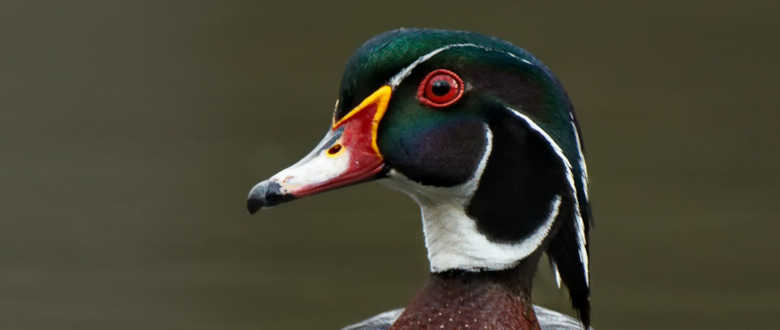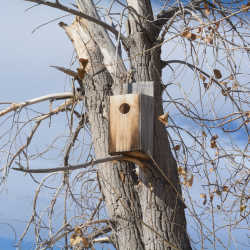↬ Hunting wood ducks is one of the most thrilling experiences while chasing waterfowl, but the tactics to be successful aren’t the same as hunting other ducks species. This Ultimate Guide provides the tips and tricks every hunter needs to target wood ducks.
Wood ducks are secretive birds that are often heard before they are seen. Their distinctive calls are usually the first warning sign before they drop out of the canopy and scream into the decoys. Wood duck hunting is a challenging sport since they prefer the thickest brush to feed and rest along rivers and creeks as well as in farm ponds and lakes.
In this guide, we’ll take a look at the best methods for hunting wood ducks including shot sizes, choke tubes, and decoys that work the best. And we’ll discuss things to avoid that most rookie wood duck hunters learn the hard way.
![]()

- Wood Duck Hunting Tips
- Best Shot Sizes for Wood Duck Hunting
- Best Chokes for Hunting Wood Ducks
- Best Wood Duck Hunting Methods
- Best Ammo for Wood Duck Hunting
- Do wood ducks fly in the rain?
- Tips for hunting wood ducks
- How to increase wood duck harvests each year
- Tips for building wood duck boxes
- About Wood Ducks
- Bottom Line: Wood Duck Hunting is Fast Paced
Wood Duck Hunting Tips
Wood ducks are hunted in every flyway in the United States and often prefer the thickest brush to both feed and rest. Hunting wood ducks can be challenging due to their erratic behavior in the air and their keen eyesight.
However, there are several hunting methods that have proven to work. These methods paired with the right equipment can make hunting wood ducks more successful. The following are some of the best tips for hunting wood ducks.
Best Shot Sizes for Wood Duck Hunting
The best shot sizes for wood ducks are #4 shot and #6 shot steel pellets. Wood ducks are small to medium sized waterfowl, so large pellets aren’t needed. Smaller pellets help to add pattern density that is critical for hitting these fast-moving birds.
#4 Shot
4 shot is the best shot size for open water decoy setups for wood ducks on lakes, rivers, and ponds. It has the range to be effective to 35 yards and is capable of complete pass throughs for maximum knock down power. 1 ounce of #4 shot contains 191 pellets, which is more than enough pattern density for clean harvests.
#6 Shot
6 shot is the ideal shot size for hunting wood ducks in flooded timber and thick flooded sloughs. These pellets have a max effective range of 30 yards. 1 ounce of #6 shot contains 315 pellets. 6 shot works well with improved cylinder chokes in these conditions.
SUMMARY
When hunting wood ducks in thick cover, use 6 shot steel. It will have the best pellet density and wide pattern inside 30 yards to successfully hit fast moving birds. For open water, 4 shot steel is preferred and can extend the range up to 35 yards.
Best Chokes for Hunting Wood Ducks
The top choke tubes to hunt wood ducks with are improved cylinder and skeet chokes. These two choke sizes work well with small steel shot at close ranges. The openness of the choke allows the pellets to spread faster and reduces the chance a wood duck could slip through the pattern.
Improved Cylinder Choke
IC choke tubes have a diameter of 0.716” in 12-gauge fixed choke shotguns. Improved cylinder is the most popular choke for hunting wood ducks over decoys. Paired with #4 shot loads, it’s capable of delivering dense patterns out to 35 yards.
Skeet Choke
Skeet chokes aren’t typically used for waterfowl, but they make a great option for tight hunting conditions in thick brush or trees where wood ducks love to hang out. Skeet chokes have a diameter of 0.719” in 12-gauged fixed full chokes.

Best Wood Duck Hunting Methods
Wood ducks are found in the Pacific, Central, Mississippi, and Atlantic flyways. Most states have resident populations of wood ducks that nest and stay year-round. This can make hunting them challenging, but the three most popular methods to hunt wood ducks are decoying, sneaking, and float hunting.
1) Decoying
The art of decoying wood ducks is the most fulfilling type of waterfowl hunting you can experience. Wood ducks dip and dive through the trees and their aerial acrobatics are an impressive feat. Not many decoys are needed to hunt wood ducks, and usually 3 to 4 do the trick. It’s usually best to place them at the open water areas since wood ducks typically land there before they swim back to the thicker brush.
2) Sneaking
Pond jumping or sneaking, is another method for hunting wood ducks that doesn’t take a lot of effort. It’s best used where there are features that allow you to sneak up close like pond dams, hillsides, and draws. Sneaking up on wood ducks can provide some quick and successful shooting when nothing else is working.
3) Float Hunting
Small rivers and creeks are the perfect place to try scull hunting for wood ducks. Low profile layout boats perform the best, but any boat can work as long as you stay concealed and let the current guide you as close as possible. Once you’re close enough, simply raise up and put the bead on the bird.
SUMMARY
Hunting over a spread of decoys is the most popular way to hunt wood ducks. Leave the big spreads at home though, as wood ducks prefer small spreads of 3-4 decoys.
Best Ammo for Wood Duck Hunting
The best ammo to hunt wood ducks is a 1 ¼ ounce load of steel #4’s traveling 1400 fps. Since most shots are close, steel will do just fine and smaller pellets will give you the pattern density to prevent any holes from forming that wood ducks could slip past. This load contains 239 pellets.
Light loads are also effective in 1 ounce or 1 1/8 ounce, but patterning should be done to identify any deficiencies due to lower pellet counts. Common ballistic benchmarks base lethality for waterfowl loads on being able to put 3 pellets in a bird at range. If your pattern is blotchy with holes and gaps, the 3 pellet rule may not be achievable consistently leading to underperformance.

Do wood ducks fly in the rain?
Wood ducks, like most waterfowl, will fly in the rain. Rainy conditions can limit the movement of wood ducks, but it won’t prevent them from flying to an area they want to be in. Wood ducks typically make the best of lulls in the rain and will fly hot and fast before the rain starts up again.
Thunderstorms and lighting are two conditions that can prevent wood ducks from flying. They typically hunker down in the worst weather and wait for it to pass. Planning to hunt wood ducks after the rain or worst of the weather has passed is usually best. You likely won’t miss much, and you’ll be there right at the time it lets up and birds finally start moving.
Tips for hunting wood ducks
- Scout in early morning and late evening to find where wood ducks roost
- Less decoys are always better for wood ducks (3-4 decoys are sufficient)
- Wood duck calls can help guide birds to your location (ditch the mallard call)
- Set decoys in open water, as wood ducks swim back to thicker brush
- Keep an eye out for birds swimming into your decoys from up stream
- Use #4 or #6 shot for dense patterns
- IC or Skeet chokes can open the pattern quickly in timber or brush
How to increase wood duck harvests each year
The best way to attract wood ducks and improve hunting is to install wood duck boxes. Wood ducks are cavity nesters, and they seek out hollow tree limbs and trunks to make their nest. Sometimes the abundance of tree cavities is low, which makes installing your own nesting box critical to keeping birds in your area and helping the population grow.
Wood duck boxes are wooden boxes elevated over water that allow wood ducks to enter and construct a nest inside. These protective enclosures are more secure than some natural cavities and can be placed in the ideal areas. Once the eggs develop and the hatchings leave the box, they simply hop down into the water where the female wood duck is usually waiting.

Wood duck nest boxes are made out of hard woods such as cedar and cypress which are cooler in the summer. They are mounted approximately 4 feet above the water on 4×4 posts driven into the mud or on trees. Metal guards can be placed around the support posts to keep snakes and other predators from reaching the nest.
Wood chips can be placed on the inside of the box for a soft place to lay eggs. Wood duck boxes are often used by other species, including tree ducks, mallards, and certain owl species. By installing wood duck boxes around your hunting holes, the chances you’ll have better hunting during duck season greatly increases.

Tips for building wood duck boxes
- Follow one of the many duck box building diagrams
- Use durable and cooler wood types (cedar, cypress, etc.)
- Place in areas that wood ducks regularly use
- Ponds that will have water in the spring and summer are ideal (avoid areas that dry up)
- Chicken wire can be placed inside the box below the opening to help chicks climb out
- Aluminum sheeting formed in a cone and placed around the base of the box can prevent predators from accessing it
- Place the opening to the box opposite to that of the sun
- Install an access panel to clean the box after each use
- Put wood chips on the bottom of the box for added cushion insulation
About Wood Ducks
Wood ducks (Aix sponsa) are a species of perching ducks that reside in many parts of the United States and North America. Many wood ducks do migrate, but those that call the south home can be full time residents. The drake wood duck is one of the most colorful waterfowl species in North America.
Wood ducks share their genus with the Mandarin Duck that is prevalent in eastern Asia and used as an ornamental pet in the U.S. The average weight of a wood duck is 24 oz. with a wingspan of 28 inches.
Wood ducks inhabit creeks, swamps, small rivers, and ponds. They feed on acorns, pecans, and various aquatic vegetation. Wood ducks are hunted each year in the U.S. and have bag limits set each fall based on population estimates.
Wood Duck Hunting FAQs
Where is the best wood duck hunting?
The best wood duck hunting is in ponds and rivers where they feed and loaf. Wood ducks typically roost in thick brush while perching on low tree limbs and stumps. At daybreak, they leave the roost in search of food and safety.
Wood ducks prefer to feed on acorns, pecans, and aquatic vegetation. Keying in on areas where wood ducks feed is one of the best ways to have a good hunt. Scouting before hand to find where they spend the day and when they head back to the roost can help focus efforts to maximize success in the field.
Where do wood ducks go during the day?
During the day, wood ducks go to feed in small ponds, rivers, and lakes. They start their day by leaving the roost at daylight. Wood ducks roost at night in thick vegetation. Often a wood duck roost is impassable to walk through.
The first hint at daylight signals wood ducks to take to the air and head for food. This can be earlier than 30 minutes before sunrise. The destination depends on known food sources and places where they can spend the day in safety from both predators and hunters.
Wood ducks can be found during the day loafing with other duck species such as mallards and teal. Wood ducks that inhabit rivers and streams with a decent current tend to rest on sandbars and tree stumps. Once daylight fades, wood ducks head back to the protection of the roost to spend the night.
Do wood ducks taste good?
Wood ducks are one of the best eating ducks. They taste mildly gamey when prepared medium rare on the grill. The taste profile is similar to mallards, teal, and gadwalls.
Wood duck meat is medium red in color and breast meat contains about 40 grams of protein. Compared to bluebills, ringnecks, and ruddy ducks, the taste of wood ducks is a night and day difference.
The best way to cook wood duck is to pluck them and slow roast or smoke for 4-6 hours until done. The meat will fall off the bone. Another option is to remove the breast meat and grill to medium rare.
Can you hunt a wood duck?
Yes, wood ducks can be hunted during duck season. Laws and regulations limit the times you can hunt wood ducks and the bag limits you can take. It’s best to visit your States’ fish and game website to read up on when you can hunt wood ducks.
Bag limits have increased on wood ducks over the years and some States allow harvesting 3 or more. Early wood duck season is also a possibility as they have been included in early teal season in some locales. Hunting wood ducks is one of the most challenging and rewarding outdoors activities. This guide lists the states that harvest the most wood ducks each year.
Bottom Line: Wood Duck Hunting is Fast Paced
Wood duck hunting is a fast-paced sport that involves birds screaming through the trees at breakneck speeds. These birds love thick brush and flooded timber, making reaching some of the best hunting spots difficult. Scouting wood duck roosts helps pinpoint where birds feed during the day and identify the best place to set up decoys.
The best shot sizes for wood ducks are #4 shot and #6 shot. Both small steel pellets provide dense patterns for up close hunting. Improved cylinder and skeet choke tubes work well with #4 shot and #6 shot in timber hunting situations.
Less decoys are best when hunting wood ducks. 3-4 decoys strategically placed is all you need. Wood ducks prefer to land in the open and swim back in the brush if the option is available. And don’t count out a rainy day. Wood ducks will still fly in the rain. It may just be a quick flight, but it can be worth it.
Constructing wood duck boxes where you hunt can help increase the wood duck population. These birds are cavity nesters, and if tree cavities are in short supply, you could be giving the birds a better option than what would otherwise be available.
Was this helpful?
Search Chokes by Gauge
Related Posts



